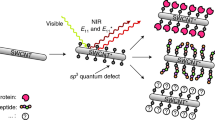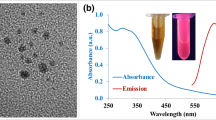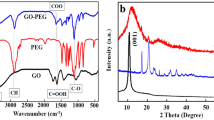Abstract
One of the fastest moving and most exciting interfaces of nanotechnology is the use of quantum dots (QDs) in biology. The unique optical properties of QDs make them appealing as in vivo and in vitro fluorophores in a variety of biological investigations, in which traditional fluorescent labels based on organic molecules fall short of providing long-term stability and simultaneous detection of multiple signals. The ability to make QDs water soluble and target them to specific biomolecules has led to promising applications in cellular labelling, deep-tissue imaging, assay labelling and as efficient fluorescence resonance energy transfer donors. Despite recent progress, much work still needs to be done to achieve reproducible and robust surface functionalization and develop flexible bioconjugation techniques. In this review, we look at current methods for preparing QD bioconjugates as well as presenting an overview of applications. The potential of QDs in biology has just begun to be realized and new avenues will arise as our ability to manipulate these materials improves.
This is a preview of subscription content, access via your institution
Access options
Subscribe to this journal
Receive 12 print issues and online access
$259.00 per year
only $21.58 per issue
Buy this article
- Purchase on Springer Link
- Instant access to full article PDF
Prices may be subject to local taxes which are calculated during checkout






Similar content being viewed by others
References
Miyawaki, A. Visualization of the spatial and temporal dynamics of intracellular signaling. Dev. Cell 4, 295–305 (2003).
Schrock, E. et al. Multicolor spectral karyotyping of human chromosomes. Science 273, 494–497 (1996).
Bruchez, M., Jr, Moronne, M., Gin, P., Weiss, S. & Alivisatos, A. P. Semiconductor nanocrystals as fluorescent biological labels. Science 281, 2013–2016 (1998).
Chan, W. C. W. & Nie, S. Quantum dot bioconjugates for ultrasensitive nonisotopic detection. Science 281, 2016–2018 (1998).
Dabbousi, B. O. et al. (CdSe)ZnS core-shell quantum dots: synthesis and optical and structural characterization of a size series of highly luminescent materials. J. Phys. Chem. B 101, 9463–9475 (1997).
Leatherdale, C. A., Woo, W. K., Mikulec, F. V. & Bawendi, M. G. On the absorption cross section of CdSe nanocrystal quantum dots. J. Phys. Chem. B 106, 7619–7622 (2002).
Murphy, C. J. Optical sensing with quantum dots. Anal. Chem. 74, 520A–526A (2002).
Parak, W. J. et al. Biological applications of colloidal nanocrystals. Nanotech. 14, R15–R27 (2003).
Niemeyer, C. M. Nanoparticles, proteins, and nucleic acids: biotechnology meets materials science. Angew. Chem. Int. Edn Eng. 40, 4128–4158 (2001).
Alivisatos, P. The use of nanocrystals in biological detection. Nature Biotechnol. 22, 47–52 (2004).
Mattoussi, H., Kuno, M. K., Goldman, E. R., Anderson, G. P. & Mauro, J. M. in Optical Biosensors: Present and Future (eds Ligler, F. S. & Rowe C. A.) 537–569 (Elsevier, Amsterdam, Netherlands, 2002).
Nirmal, M. et al. Fluorescence intermittency in single cadmium selenide nanocrystals. Nature 383, 802–806 (1996).
Efros, A. L. & Rosen, M. Random telegraph signal in the photoluminescence intensity of a single quantum dot. Phys. Rev. Lett. 78, 1110–1113 (1996).
Hines, M. A. & Guyot-Sionnest, P. Synthesis and characterization of strongly luminescing ZnS-Capped CdSe nanocrystals. J. Phys. Chem. 100, 468–471 (1996).
Peng, Z. A. & Peng, X. Formation of high-quality CdTe, CdSe, and CdS nanocrystals using CdO as precursor. J. Am. Chem. Soc. 123, 183–184 (2001).
Bailey, R. E. & Nie, S. Alloyed semiconductor quantum dots: tuning the optical properties without changing the particle size. J. Am. Chem. Soc. 125, 7100–7106 (2003).
Gu, H., Ho, P.-L., Tsang, K. W. T., Wang, L. & Xu, B. Using Biofunctional magnetic nanoparticles to capture vancomycin-resistant enterococci and other gram-positive bacteria at ultralow concentration. J. Am. Chem. Soc. 125, 15702–15703 (2003).
Gu, H., Zheng, R., Zhang, X. & Xu, B. Facile one-pot synthesis of bifunctional heterodimers of nanoparticles: A conjugate of quantum dot and magnetic nanoparticles. J. Am. Chem. Soc. 126, 5664–5665 (2004).
Pinaud, F., King, D., Moore, H.-P. & Weiss, S. Bioactivation and cell targeting of semiconductor CdSe/ZnS nanocrystals with phytochelatin-related peptides. J. Am. Chem. Soc. 126, 6115–6123 (2004).
Tsay, J. M., Pflughoefft, M., Bentolila, L. A. & Weiss, S. Hybrid approach to the synthesis of highly luminescent CdTe/ZnS and CdHgTe/ZnS nanocrystals. J. Am. Chem. Soc. 126, 1926–1927 (2004).
Xu, C. J. et al. Nitrilotriacetic acid-modified magnetic nanoparticles as a general agent to bind histidine-tagged proteins. J. Am. Chem. Soc. 126, 3392–3393 (2004).
Murray, C. B., Kagan, C. R. & Bawendi, M. G. Synthesis and characterization of monodisperse nanocrystals and close-packed nanocrystal assemblies. Ann. Rev. Mater. Sci. 30, 545–610 (2000).
Xu, C. J. et al. Dopamine as a robust anchor to immobilize functional molecules on the iron oxide shell of magnetic nanoparticles. J. Am. Chem. Soc. 126, 5664–5665 (2004).
Murray, C. B., Norris, D. J. & Bawendi, M. G. Synthesis and characterization of nearly monodisperse CdE (E = sulfur, selenium, tellurium) semiconductor nanocrystallites. J. Am. Chem. Soc. 115, 8706–8715 (1993).
Peng, X., Schlamp, M. C., Kadavanich, A. V. & Alivisatos, A. P. Epitaxial growth of highly luminescent CdSe/CdS core/shell nanocrystals with photostability and electronic accessibility. J. Am. Chem. Soc. 119, 7019–7029 (1997).
Mattoussi, H. et al. Self-assembly of CdSe-ZnS quantum dot bioconjugates using an engineered recombinant protein. J. Am. Chem. Soc. 122, 12142–12150 (2000).
Hines, M. A. & Guyot-Sionnest, P. Bright UV-blue luminescent colloidal ZnSe nanocrystals. J. Phys. Chem. B 102, 3655–3657 (1998).
Suyver, J. F., Wuister, S. F., Kelly, J. J. & Meijerink, A. Synthesis and photoluminescence nanocrystalline ZnS:Mn2+. Nano Lett. 1, 429–433 (2001).
Artmeyev, M. V., Gaponenko, S. V., Germanenko, I. N. & Kapitonov, A. M. Irreversible photochemical spectral hole burning in quantum-sized CdS nanocrystals embedded in a polymeric film. Chem. Phys. Lett. 243, 450–455 (1995).
Reiss, P., Bleuse, J. & Pron, A. Highly luminescent CdSe/ZnSe core/shell nanocrystals of low size dispersion. Nano Lett. 2, 781–784 (2002).
Guo, W., Li, J. J., Wang, Y. A. & Peng, X. Conjugation chemistry and bioapplications of semiconductor box nanocrystals prepared via dendrimer bridging. Chem. Mater. 15, 3125–3133 (2003).
Hong, R. et al. Control of protein structure and function through surface recognition by tailored nanoparticle scaffolds. J. Am. Chem. Soc. 126, 739–743 (2004).
Dubertret, B. et al. In vivo imaging of quantum dots encapsulated in phospholipids micelles. Science 298, 1759–1762 (2002).
Wu, X. et al. Immunofluorescent labeling of cancer marker Her2 and other cellular targets with semiconductor quantum dots. Nature Biotechnol. 21, 41–46 (2003).
Pellegrino, T. et al. Hydrophobic nanocrystals coated with an amphiphilic polymer shell: A general route to water soluble nanocrystals. Nano Lett. 4, 703–707 (2004).
Osaki, F., Kanamori, T., Sando, S., Sera, T. & Aoyama, Y. A quantum dot conjugated sugar ball and its cellular uptake on the size effects of endocytosis in the subviral region. J. Am. Chem. Soc. 126, 6520–6521 (2004).
Kim, S. & Bawendi, M. G. Oligomeric ligands for luminescent and stable nanocrystal quantum dots. J. Am. Chem. Soc. 125, 14652–14653 (2003).
Wang, X.-S. et al. Surface passivation of luminescent colloidal quantum dots with poly(dimethylaminoethyl methacrylate) through a ligand exchange process. J. Am. Chem. Soc. 126, 7784–7785 (2004).
Willard, D. M., Carillo, L. L., Jung, J. & Van Orden, A. CdSe-ZnS quantum dots as resonance energy transfer donors in a model protein-protein binding assay. Nano Lett. 1, 469–474 (2001).
Gerion, D. et al. Synthesis and properties of biocompatible water-soluble silicacoated CdSe/ZnS semiconductor quantum dots. J. Phys. Chem. B 105, 8861–8871 (2001).
Mitchell, G. P., Mirkin, C. A. & Letsinger, R. L. Programmed assembly of DNA functionalized quantum dots. J. Am. Chem. Soc. 121, 8122–8123 (1999).
Goldman, E. R. et al. Avidin: a natural bridge for quantum dot-antibody conjugates. J. Am. Chem. Soc. 124, 6378–6382 (2002).
Uyeda, H. T., Medintz, I. L., Jaiswal, J. K., Simon, S. M. & Mattoussi, H. Synthesis of compact multidentate ligands to prepare stable hydrophilic quantum dot fluorophores. J. Am. Chem. Soc. 127, 3870–3878 (2005).
Mattheakis, L. C. et al. Optical coding of mammalian cells using semiconductor quantum dots. Anal. Biochem. 327, 200–208 (2004).
Ballou, B., Lagerholm, B. C., Ernst, L. A., Bruchez, M. P. & Waggoner, A. S. Noninvasive imaging of quantum dots in mice. Bioconj. Chem. 15, 79–86 (2004).
Gao, X., Cui, Y., Levenson, R. M., Chung, L. W. K. & Nie, S. In vivo cancer targeting and imaging with semiconductor quantum dots. Nature Biotechnol. 22, 969–976 (2004).
Pathak, S., Choi, S. K., Arnheim, N. & Thompson, M. E. Hydroxylated quantum dots as luminescent probes for in situ hybridization. J. Am. Chem. Soc. 123, 4103–4104 (2001).
Medintz, I. L. et al. Self-assembled nanoscale biosensors based on quantum dot FRET donors. Nature Mater. 2, 630–638 (2003).
Akerman, M. E., Chan, W. C. W., Laakkonen, P., Bhatia, S. N. & Ruoslahti, E. Nanocrystal targeting in vivo. Proc. Natl Acad. Sci. 99, 12617–12621 (2002).
Slocik, J. M., Moore, J. T. & Wright, D. W. Monoclonal antibody recognition of histidine-rich peptide encapsulated nanoclusters. Nano Lett. 2, 169–173 (2002).
Hainfeld, J. F., Liu, W., Halsey, C. M. R., Freimuth, P. & Powell, R. D. Ni-NTAgold clusters target His-tagged proteins. J. Stuct. Biol. 127, 185–198 (1999).
Clapp, A. R. et al. Fluorescence resonance energy transfer between quantum dot donors and dye-labeled protein acceptors. J. Am. Chem. Soc. 126, 301–310 (2004).
Medintz, I. L., et al. A fluorescence resonance energy transfer derived structure of a quantum dot-protein bioconjugate nanoassembly. Proc. Natl Acad. Sci. 101, 9612–9617 (2004).
Medintz, I. L., Trammell, S. A., Mattoussi, H. & Mauro, J. M. Reversible modulation of quantum dot photoluminescence using a protein-bound photochromic fluorescence resonance energy transfer acceptor. J. Am. Chem. Soc. 126, 30–31 (2004).
Goldman, E. R. et al. Conjugation of luminescent quantum dots with antibodies using an engineered adaptor protein to provide new reagents for fluoroimmunoassays. Anal. Chem. 74, 841–847 (2002).
Hanaki, K. et al. Semiconductor quantum dot/albumin complex is a long-life and highly photostable endosome marker. Biochem. Biophys. Res. Comm. 302, 496–501 (2003).
Sukhanova, A. et al. Biocompatible fluorescent nanocrystals for immunolabeling of membrane proteins and cells. Anal. Biochem. 324, 60–67 (2004).
Jaiswal, J. K., Mattoussi, H., Mauro, J. M. & Simon, S. M. Long-term multiple color imaging of live cells using quantum dot bioconjugates. Nature Biotechnol. 21, 47–51 (2003).
Kaul, Z. et al. Mortalin imaging in normal and cancer cells with quantum dot immuno-conjugates. Cell Res. 13, 503–507 (2003).
Hoshino, A., Hanaki, K.-I., Suzuki, K. & Yamamoto, K. Applications of Tlymphoma labeled with fluorescent quantum dots to cell tracing markers in mouse body. Biochem. Biophys. Res. Comm. 314, 46–53 (2004).
Chen, F. & Gerion, D. Fluorescent CdSe/ZnS nanocrystal-peptide conjugates for long-term, nontoxic imaging and nuclear targeting in living cells. Nano Lett. 4, 1827–1832 (2004).
Derfus, A. M., Chan, W. C. W. & Bhatia, S. N. Intracellular delivery of quantum dots for live cell labeling and organelle tracking. Adv. Mater. 16, 961–966 (2004).
Voura, E. B., Jaiswal, J. K., Mattoussi, H. & Simon, S. M. Tracking early metastatic progression with quantum dots and emission scanning microscopy. Nature Med. 10, 993–998 (2004).
Derfus, A. M., Chan, W. C. W. & Bhatia, S. N. Probing the cytotoxicity of semiconductor quantum dots. Nano Lett. 4, 11–18 (2004).
Pellegrino, T. et al. Quantum dot-based cell motility assay. Differentiation 71, 542–548 (2003).
Dahan, M. et al. Diffusion dynamics of glycine receptors revealed by singlequantum dot tracking. Science 302, 442–445 (2003).
Lidke, D. S. et al. Quantum dot ligands provide new insights into erbB/HER receptor-mediated signal transduction. Nature Biotechnol. 22, 198–203 (2004).
Levene, M. J., Dombeck, D. A., Kasischke, K. A., Molloy, R. P. & Webb, W. W. In vivo multiphoton microscopy of deep brain tissue. J. Neurophys. 91, 1908–1912 (2004).
Rosenthal, S. J. et al. Targeting cell surface receptors with ligand-conjugated nanocrystals. J. Am. Chem. Soc. 124, 4586–4594 (2002).
Kim, S. et al. Near-infrared fluorescent type II quantum dots for sentinel lymph node mapping. Nature Biotechnol. 22, 93–97 (2004).
Larson, D. R. et al. Water-soluble quantum dots for multiphoton fluorescence imaging in vivo. Science 300, 1434–1437 (2003).
Colvin, V. L. The potential environmental impact of engineered nanomaterials. Nature Biotechnol. 21, 1166–1170 (2003).
Hoet, P. H., Bruske-Hohlfeld, I. & Salata, O. V. Nanoparticles - known and unknown health risks. J. Nanobiotechnol. 2, 2–12 (2004).
Green, M. & Howman, E. Semiconductor quantum dots and free radical induced DNA nicking. Chem. Comm. 121–123 (2005).
Kirchner, C. et al. Cytotoxicity of colloidal CdSe and CdSe/ZnS nanoparticles. Nano Lett. 5, 331–338 (2005).
Xiao, Y. & Barker, P. E. Semiconductor nanocrystal probes for human metaphase chromosomes. Nucl. Acids Res. 32, 3 e28 (2004).
Gerion, D. et al. Room-temperature single-nucleotide polymorphism and multiallele DNA detection using fluorescent nanocrystals and microarrays. Anal. Chem. 75, 4766–4772 (2003).
Gerion, D. et al. Sorting fluorescent nanocrystals with DNA. J. Am. Chem. Soc. 124, 7070–7074 (2002).
Goldman, E. R. et al. Multiplexed toxin analysis using four colors of quantum dot fluororeagents. Anal. Chem. 76, 684–688 (2004).
Mamedova, N. N., Kotov, N. A., Rogach, A. L. & Studer, J. Albumin-CdTe nanoparticle bioconjugates: preparation, structure, and interunit energy transfer with antenna effect. Nano Lett. 1, 281–286 (2001).
Tran, P. T., Goldman, E. R., Anderson, G. P., Mauro, J. M. & Mattoussi, H. Use of luminescent CdSe-ZnS nanocrystal bioconjugates in quantum dot-based nanosensors. Phys. Status Solidi B 229, 427–432 (2002).
Clapp, A. R., Medintz, I. L., Fisher, B. R., Anderson, G. P. & Mattoussi, H. Can luminescent quantum dots be efficient energy acceptors with organic dye donors. J. Am. Chem. Soc. 127, 1242–1250 (2005).
Samia, A. C. S., Chen, X. & Burda, C. Semiconductor quantum dots for photodynamic therapy. J. Am. Chem. Soc. 125, 15736–15737 (2003).
Bakalova, R., Ohba, H., Zhelev, Z., Ishikawa, M. & Baba, Y. Quantum dots as photosensitizers. Nature Biotechnol. 22, 1360–1361 (2004).
Xu, H. X. et al. Multiplexed SNP genotyping using the Qbead (TM) system: a quantum dot-encoded microsphere-based assay. Nucl. Acids Res. 31, 8 e43 (2003).
Josephson, L., Kircher, M. F., Mahmood, U., Tang, Y. & Weissleder, R. Nearinfrared fluorescent nanoparticles as combined MR/optical imaging probes. Bioconj. Chem. 13, 554–560 (2002).
Hohng, S. & Ha, T. Near-complete suppression of quantum dot blinking in ambient conditions. J. Am. Chem. Soc. 126, 1324–1325 (2004).
Hu, J. et al. Linearly polarized emission from colloidal semiconductor quantum rods. Science 292, 2060–2063 (2001).
Han, M., Gao, X., Su, J. Z. & Nie, S. Quantum-dot-tagged microbeads for multiplexed optical coding of biomolecules. Nature Biotechnol. 19, 631–635 (2001).
Katz, E. & Willner, I. Integrated nanoparticle-biomolecule hybrid systems:synthesis, properties, applications. Angew. Chem. Int. Edn Eng. 43, 6042–6108 (2004).
Ishii, D. et al. Chaperonin-mediated stabilization and ATP-triggered release of semiconductor nanoparticles. Nature 423, 628–632 (2003).
Wang, D., He, J., Rosenzweig, N. & Rosenzweig, Z. Superparamagnetic Fe2O3 beads-CdSe/ZnS quantum dots core-shell nanocomposite particles for cell separation. Nano Lett. 4, 409–413 (2004).
Mansson, A. et al. In vitro sliding of actin filaments labelled with single quantum dots. Biochem. Biophys. Res. Comm. 314, 529–534 (2004).
Bachand, G. D. et al. Assembly and transport of nanocrystal CdSe quantum dot nanocomposites using microtubules and kinesin motor proteins. Nano Lett. 4, 817–821 (2004).
Kloepfer, J. A. et al. Quantum dots as strain- and metabolism-specific microbiological labels. App. Environ. Microbiol. 69, 4205–4213 (2003).
Patolsky, F. et al. Lighting-up the dynamics of telomerization and DNA replication by CdSe-ZnS quantum dots. J. Am. Chem. Soc. 125, 13918–13919 (2003).
Menzel, E. R. et al. Photoluminescent semiconductor nanocrystals for fingerprint detection. J. Forens. Sci. 45, 545–551 (2000).
Baird, G. S., Zacharias, D. A. & Tsien, R. Y. Biochemistry, mutagenesis, and oligomerization of DsRed, a red fluorescent protein from coral. Proc. Natl Acad. Sci. 97, 11984–11989 (2000).
Michalet, X. et al. Quantum dots for live cells, in vivo imaging, and diagnostics. Science 307, 538–544 (2005).
Acknowledgements
The authors acknowledge the Naval Research Laboratory (NRL) and A. Ervin and L. Chrisey at the Office of Naval Research (ONR grant N001404WX20270) and A. Krishan at DARPA for support. I.L.M. was and H.T.U. is supported by a National Research Council Fellowship through NRL.
Author information
Authors and Affiliations
Corresponding authors
Ethics declarations
Competing interests
The authors declare no competing financial interests.
Rights and permissions
About this article
Cite this article
Medintz, I., Uyeda, H., Goldman, E. et al. Quantum dot bioconjugates for imaging, labelling and sensing. Nature Mater 4, 435–446 (2005). https://doi.org/10.1038/nmat1390
Issue Date:
DOI: https://doi.org/10.1038/nmat1390
This article is cited by
-
Bright and stable near-infrared lead-free perovskite light-emitting diodes
Nature Photonics (2024)
-
Immobilization of azide-functionalized proteins to micro- and nanoparticles directly from cell lysate
Microchimica Acta (2024)
-
Pre-ceramic polymer-assisted nucleation and growth of copper sulfide nanoplates
Communications Materials (2023)
-
Chemically and electronically active metal ions on InAs quantum dots for infrared detectors
NPG Asia Materials (2023)
-
Coherent heteroepitaxial growth of I-III-VI2 Ag(In,Ga)S2 colloidal nanocrystals with near-unity quantum yield for use in luminescent solar concentrators
Nature Communications (2023)



